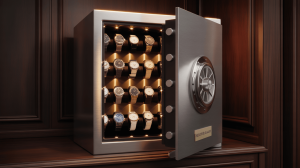Watch Safe and Winder Reviews: What to Look for Before You Buy. Here’s the deal… before you invest in a watch safe or winder, you need to know which features deliver real protection, performance, and peace of mind.
1. Security Ratings and Certifications
A credible safe carries UL RSC or ETL burglary ratings and UL 72 Class 350 fire certification. These standards guarantee resistance to prying, drilling, and heat. Look for multi-bolt steel doors, reinforced hinges, and intumescent gaskets that seal out flames and smoke. Without these ratings, a safe might offer false confidence against real threats.
| Certification | Test Standard | Protection Level |
|---|---|---|
| UL RSC | Pry-bar and drill resistance | 5–10 min forced-entry delay |
| ETL Burglary | Independent lab burglary test | Equivalent anti-pry performance |
| UL 72 Class 350 | 30 min at 1,200 °F | Interior below 350 °F |
2. Build Quality and Materials
Not all safes use the same steel gauge or weld quality. Premium models employ 12–14 gauge steel with continuous weld seams for maximum rigidity. Interiors often combine powder-coat finishes for scratch resistance and corrosion-proof hardware. Cheap safes cut corners with thinner walls and spot welds that compromise integrity under attack.
3. Lock Mechanism Options
Safes offer mechanical combination dials, electronic keypads, and biometric scanners. Mechanical dials never fail for lack of power but lack audit logs. Keypads allow multiple user codes and time delays while biometric scanners grant fingerprint access but need re-enrollment. Dual-lock systems combine methods for layered security—ideal for high-value collections.
4. Winder Module Performance
For automatic watches, winding modules must match each caliber’s turns-per-day (TPD) and rotation direction requirements. Quality winders use precision Japanese or Swiss motors under 25 dB and programmable pause intervals to prevent over-winding. Removable trays let you wind only active automatics while static bays store others.
| Feature | Specification | Benefit |
|---|---|---|
| TPD Range | 650–2,000 turns/day | Matches manufacturer specs |
| Direction Control | CW, CCW, bi-directional | Prevents winding stress |
| Noise Level | < 25 dB | Silent operation in homes/offices |
5. Interior Organization and Capacity
A well-organized safe separates watches, jewelry, and documents. Look for modular foam inserts, velvet-lined pillows, ring rolls, and hidden drawers. Calculate capacity by assigning roughly 2 inches width per watch pillow and additional slots for straps or paperwork. Avoid overcrowding, which risks scratches and hampers retrieval.
6. Fire and Climate Protection
Even brief exposure to heat can ruin movements and gems. Seek safes with composite fireboard or ceramic insulation and intumescent seals that expand to fill gaps. Climate-sealed doors with IP54 ratings block dust and moisture, while integrated desiccant packs or active dehumidifiers maintain 40–50 % relative humidity.
7. Portability and Installation
Consider whether you need a portable safe for travel or a fixed home unit. Portable models use lightweight alloys and carry handles but offer lower ratings. Home safes bolt into studs or concrete using heavy-duty anchors. Level installation prevents binding, and concealed anchor plates maintain a clean look.
| Installation Type | Location | Security Impact |
|---|---|---|
| Portable Safe | Carry-on luggage/home | Moderate (quick removal risk) |
| Bolt-down Home Safe | Floor or wall | Very high (immovable fixture) |
8. Smart Connectivity Features
Modern safes integrate Bluetooth or Wi-Fi for tamper, door-open, and low-battery alerts. Smartphone apps allow remote lock/unlock, winding schedule adjustments, and access-log reviews. Encrypted connections and strong passwords are essential to prevent hacking.
9. Power Supply and Backup Options
Electronic locks and winders rely on AC adapters and rechargeable batteries. Look for low-battery LED or app notifications and USB-C charging options. Always ensure a hidden manual override—mechanical key or dial—to avoid lockouts when power fails.
10. Noise and Vibration Dampening
High-quality winders and locking bolts can generate noise. Seek rubber-dampened motor mounts, precision bearings, and soft-close hinges that keep operation under 25 dB. Silent features matter when safes live in bedrooms or offices where peace is valued.
| Component | Noise Rating | User Benefit |
|---|---|---|
| Motor Mounts | Rubber-dampened | Reduces mechanical vibration |
| Soft-Close Hinges | Hydraulic mechanism | Eliminates door slams |
11. Aesthetic Finishes and Customization
Your safe should fit your décor—from matte black steel to walnut veneer or leather wrap. Custom engraving or logo inlays elevate the piece to furniture-grade art. Verify UV-stable finishes and scratch-resistant coatings for long-term appearance.
12. Price vs. Value Analysis
Entry-level safes start at $100–$300 with basic steel walls and key locks. Mid-range ($300–$700) adds fire rating, climate control, and electronic locks. Premium models ($700+) include biometrics, winder modules, smart connectivity, and luxury finishes. Prioritize core certifications before optional extras.
13. Maintenance and Upkeep
Regular care extends safe life: dust exterior monthly, test locks quarterly, replace desiccant packs and batteries annually, and run winders empty to prevent motor stale-spots. Keep a maintenance log to track service dates and issues.
14. User Reviews and Brand Reputation
Before purchase, read real-user reviews on noise levels, build quality, and customer support responsiveness. Brands with long-standing industry presence and transparent certification documentation earn higher trust among collectors and professionals.
| Brand Reputation | Key Strengths | Watch-Friendly Features |
|---|---|---|
| Brand A | Superior security ratings | Quiet winders, strong anchors |
| Brand B | Elegant finishes | Integrated lighting, HDMI-style |
15. Final Buying Checklist
Compile your requirements—security ratings, fire protection, winder specs, capacity, power options, noise level, connectivity, finishes, and budget—into a comparison chart. Score shortlisted models against each factor to select the best watch safe and winder that suits your lifestyle and collection.
Conclusion
Evaluating watch safes and winders means balancing security, preservation, and presentation. Here’s the deal… by focusing on certified protection, precise winding, and thoughtful organization, you’ll choose a vault that keeps your timepieces safe, accurate, and beautifully displayed.
FAQ
Q1: Do all watch safes include winders?
No—verify modular winder bays or separate winding trays before purchase.
Q2: How often should I replace desiccant packs?
Every 6–12 months depending on humidity levels.
Q3: Are biometric locks secure?
Premium scanners use encrypted templates and include backup override options.
Q4: Can smart safes be hacked?
Use strong unique passwords and enable firmware updates to minimize risk.
Q5: What’s the ideal number of watch bays?
Choose capacity for current collection plus 20–30 % extra room for growth.







